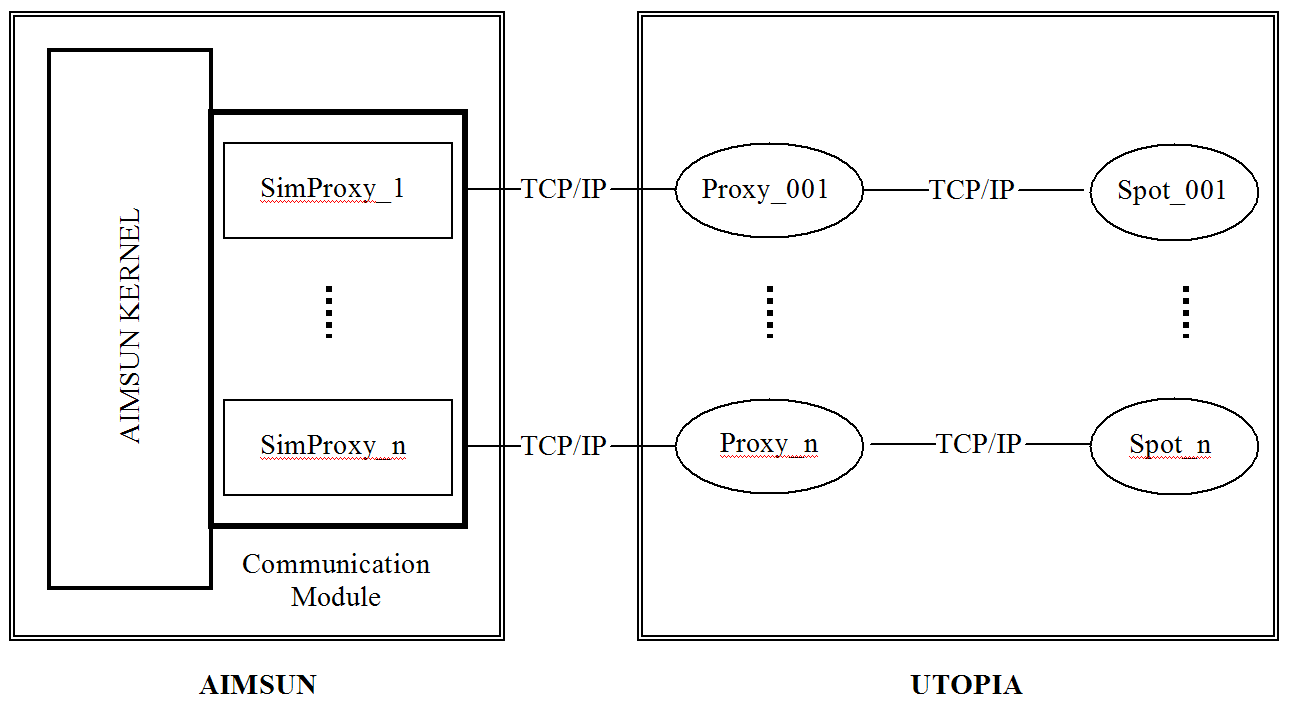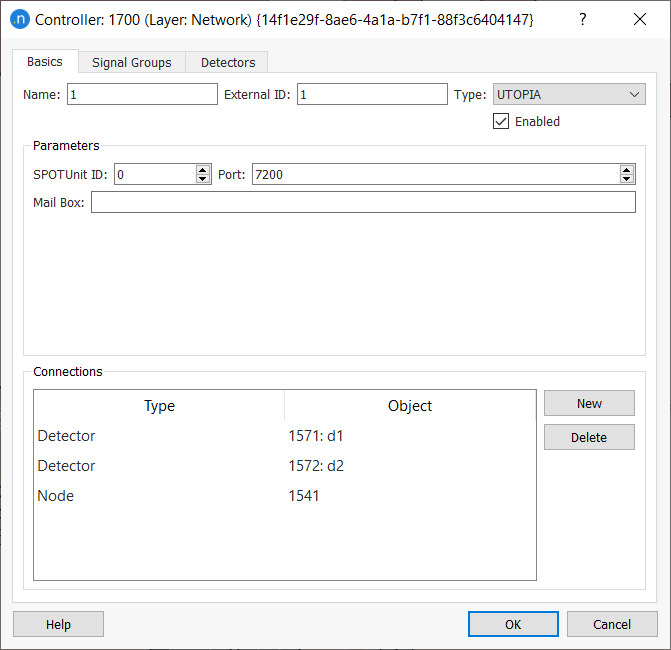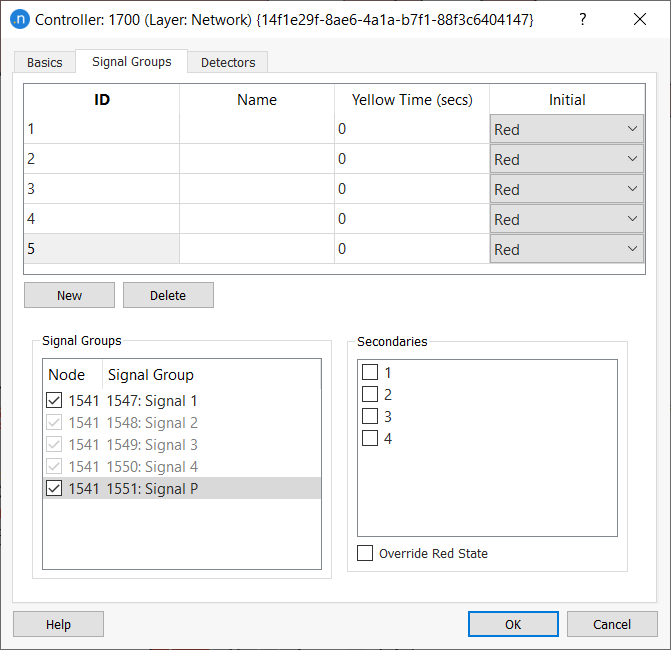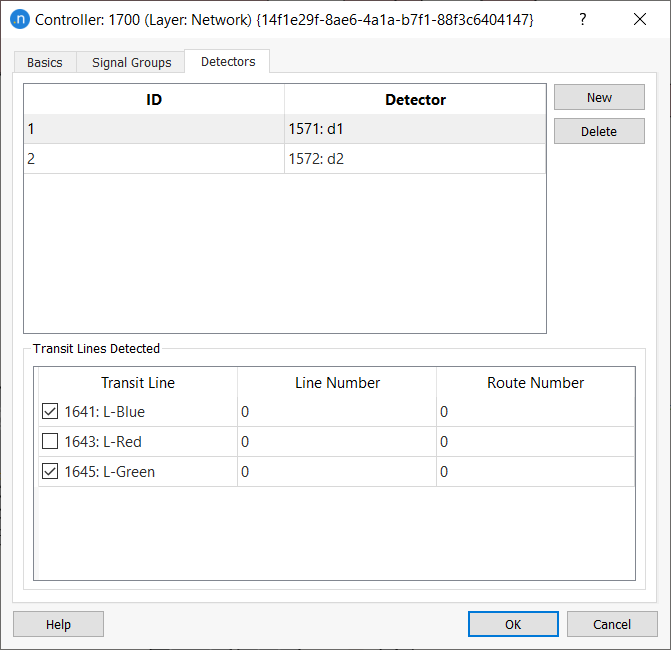Aimsun Next: UTOPIA Interface¶
UTOPIA from Swarco is an adaptive traffic control system designed to optimize flows and give selective priority to transit without sacrificing travel times for private traffic.
Architecture¶
Communication between Aimsun Next and UTOPIA is between a "Proxy" unit in Utopia and "SimProxy" software module in Aimsun Next. Each Proxy unit in Utopia represents a SPOT unit and communicates with an Aimsun controller via TCP/IP to a SimProxy unit linked to and Aimsun controller.
The architecture, as the figure below shows, creates one instance of SimProxy per each SPOT Unit (intersection control unit) defined in UTOPIA, and the communication is between each SimProxy unit and the corresponding Proxy unit in UTOPIA. Each SimProxy unit acts as a controller and each connection is identified by a communication port number.
The Utopia interface can be configured to produce debugging information. This option is selected in the Scenario Editor. When this option is active, Aimsun Next will generate a log file SPOTUnitID.log where ID is the UTOPIA SPOT Unit ID.

Relationship between Aimsun objects and UTOPIA objects¶
To guarantee a correct connection between Aimsun Next and UTOPIA, the UTOPIA objects must correspond to the matching Aimsun objects. These relationships are defined by:
-
SPOT Unit in UTOPIA: Each SPOT Unit has to be represented in Aimsun Next as one UTOPIA type controller.
-
UTOPIA Intersections: One UTOPIA intersection can be represented by one (or more than one) Aimsun Next junction. All intersections controlled by one SPOT Unit have to be represented as connections between its UTOPIA controller and the Aimsun Next junctions that represent each intersection.
-
UTOPIA Signal Groups: The Aimsun model must contain the same signal group definitions as the UTOPIA model with the same turnings associated.
-
UTOPIA Detector: UTOPIA has two types of detectors:
- Physical detectors, which measure "count" and "occupancy".
- Logical detectors, which identify transit vehicles and are associated with one physical detector and a set of transit lines.
Each physical detector in UTOPIA (physical detector itself or the physical detector associated with one logical detector) has to be modeled as one simulated detector. If this detector corresponds to one physical detector then the simulated detector must have, at least, Count and Occupancy as measuring capabilities and if this detector represents one physical detector associated with one Logical detector then the detector modeled in Aimsun Next must have, at least, Equipped Vehicle as a measuring capability. All transit lines associated with Logical detectors have to be modeled in Aimsun Next as transit lines with 100% Equipped vehicles in the transit vehicle types.
Control Plan: For each intersection controlled by UTOPIA, it is necessary to define a pre-timed or fixed control plan with the definition of all phases with their durations. This definition of the control plan will be applied when UTOPIA considers the corresponding SPOT Unit has to work with "Local" status. After that, set the control type as External.
Aimsun Next - UTOPIA interchange information¶
Aimsun Next and UTOPIA interchange of information (synchronization tokens, detector measures, stages, etc.) takes place every second as one of UTOPIA’ requirements. The detection cycle should therefore be set to 1 second. If the simulation step is not 1 second, the data synchronization rules apply.
UTOPIA objects definition in Aimsun Next¶
The definition of the UTOPIA objects in Aimsun Next is based on defining one UTOPIA controller in the Aimsun Next model for each SPOT Unit.
A double-click will open the dialog window associated with the controller.
In the Basics tab the options are:
- SPOTUnit ID: The SPOT Unit Identifier
- Port: The communication port number defines the communication between Aimsun Next and the SPOT Unit
- Mail Box: A string included in all messages header interchanged between Aimsun Next and the SPOT Unit. This string by default is "WAN_INP"
- Connections: Defines the connections between the controller and those devices under its control by pressing the new button and then clicking on the required object (detectors or junctions). All junctions and detectors controlled by the SPOT Unit have to be connected.

Signal Groups Tab¶
The second step is to establish how the controller ‘sees’ the different signal groups. Each UTOPIA signal group has:
- ID: which is the UTOPIA signal group identifier. In one controller, these identifiers have to be consecutive and start from 1. These identifiers determine the order in which Aimsun Next will receive its state and this order has to be the same as UTOPIA has in its configuration.
- Name: is the UTOPIA signal group name (optional)
- Yellow Time (secs): is the yellow time (expressed in seconds) that determines the duration of the yellow state during the transition of this signal group from GREEN to RED.
- Initial: is the initial state of the SCATS signal group at the beginning of the simulation.
Secondary signal groups can be assigned to a signal group.
A set of Aimsun signal groups can be associated with a single UTOPIA group so they can be controlled together. The example below shows signal with UTOPIA ID 1 linked to signal group 1 in the simulation.

Detectors tab¶
The third step is to establish how the controller ‘sees’ the different detectors. To add a new UTOPIA detector: 1. Click on the New button. 2. Set the ID. 3. Select a detector from the list of detectors connected to the controller.
Each UTOPIA detector has as attributes:
- ID: which represents the UTOPIA bitnumber (greater than or equal to zero and not necessarily consecutive). This bitnumber determines the order in which Aimsun Next will send the detector measures. If the bitnumber is not present, then Aimsun Next will send zero as occupancy and count.
- Detector ID and Name: is the modeled detector associated with this UTOPIA detector.
- Transit Lines: Detected defines the transit lines associated with one Logical detector (if the UTOPIA detector corresponds to a physical detector then no transit lines are selected). In this type of detector, Aimsun Next will send the Transit Vehicle Identifier as a count measure.
